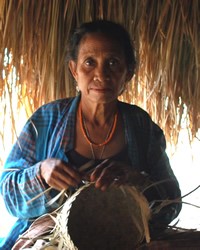Bunak, Mare in Indonesia

Photo Source:
David Palazón - Wikimedia
Creative Commons
|
Send Joshua Project a map of this people group.
|
| People Name: | Bunak, Mare |
| Country: | Indonesia |
| 10/40 Window: | Yes |
| Population: | 25,000 |
| World Population: | 101,000 |
| Primary Language: | Bunak |
| Primary Religion: | Ethnic Religions |
| Christian Adherents: | 4.94 % |
| Evangelicals: | 0.50 % |
| Scripture: | Translation Started |
| Ministry Resources: | No |
| Jesus Film: | No |
| Audio Recordings: | No |
| People Cluster: | Timor |
| Affinity Bloc: | Malay Peoples |
| Progress Level: |
|
Introduction / History
The island of Timor measures about 280 miles long and up to 65 miles wide. The Portuguese settled on Timor in the early 1500s, and Dutch traders first landed on the island in 1613. The Portuguese and Dutch competed for influence until a series of agreements established boundaries between their holdings. Dutch Timor, centered in the west, became part of the Republic of Indonesia in 1950. Portuguese Timor, centered in the east, was forcibly annexed by Indonesia in late 1975.
The Bunak are one of the major people groups on the island. They live in the central interior of Timor Island in the province of Nusa Tenggara and in East Timor. The Bunak live primarily in the mountains, having been driven there by the current costal inhabitants of the island. The Bunak language is not closely related to any other language and is spoken only by the Bunak.
What Are Their Lives Like?
Like the other peoples of Timor, the Bunak make their living primarily through agriculture. They use traditional cultivation methods, to produce maize, rice, coffee, mangoes, candlenuts, and copra (dried coconut meat yielding oil).
Bunak villages often consist of individual settlements. In the mountains, the people live on swiddens (land that has been cleared by "slash and burn" agriculture) for part of the year. After harvesting the crops, however, they return to their home villages. Each village has a sacred house, with a custodian priest and a surrounding taboo area. Because of former coastal warfare, the Bunak have built stockades to surround villages and isolated houses.
The Bunak trace their descent through both the males and females, and the circle of kinship is divided into various sub-groups. The center, however, is the nuclear family, composed of a man, woman and their children.
The Bunak people have an oral tradition of stories involving deception, treachery and brutality. Bunak folklore reinforces their reputation of ferocity. They typically don't interact with other nearby tribes.
What Are Their Beliefs?
Like other remote tribes in Indonesia, the Bunak practice ethnic and animistic religions (belief that non-human objects have spirits). The Bunak also practice ancestor worship (praying to deceased relatives for guidance, blessing and protection). A minority of the Bunak are Christian believers. (On East Timor, the Christian Bunak minority is significantly larger).
What Are Their Needs?
The Bunak people need dependable electricity, running water, good schools and medical clinics.
No scripture or other Christian resources are available in the Bunak language.
Prayer Points
Pray for a translation of the New Testament into the Bunak language.
Pray for growth among the Bunak believers as disciples and disciple-makers.
Ask God to raise up gospel workers from among the Bunak on East Timor and send them to the Bunak in Indonesia.
Pray for an unstoppable movement to Christ among the Bunak people that will spread to the other tribes on the island.